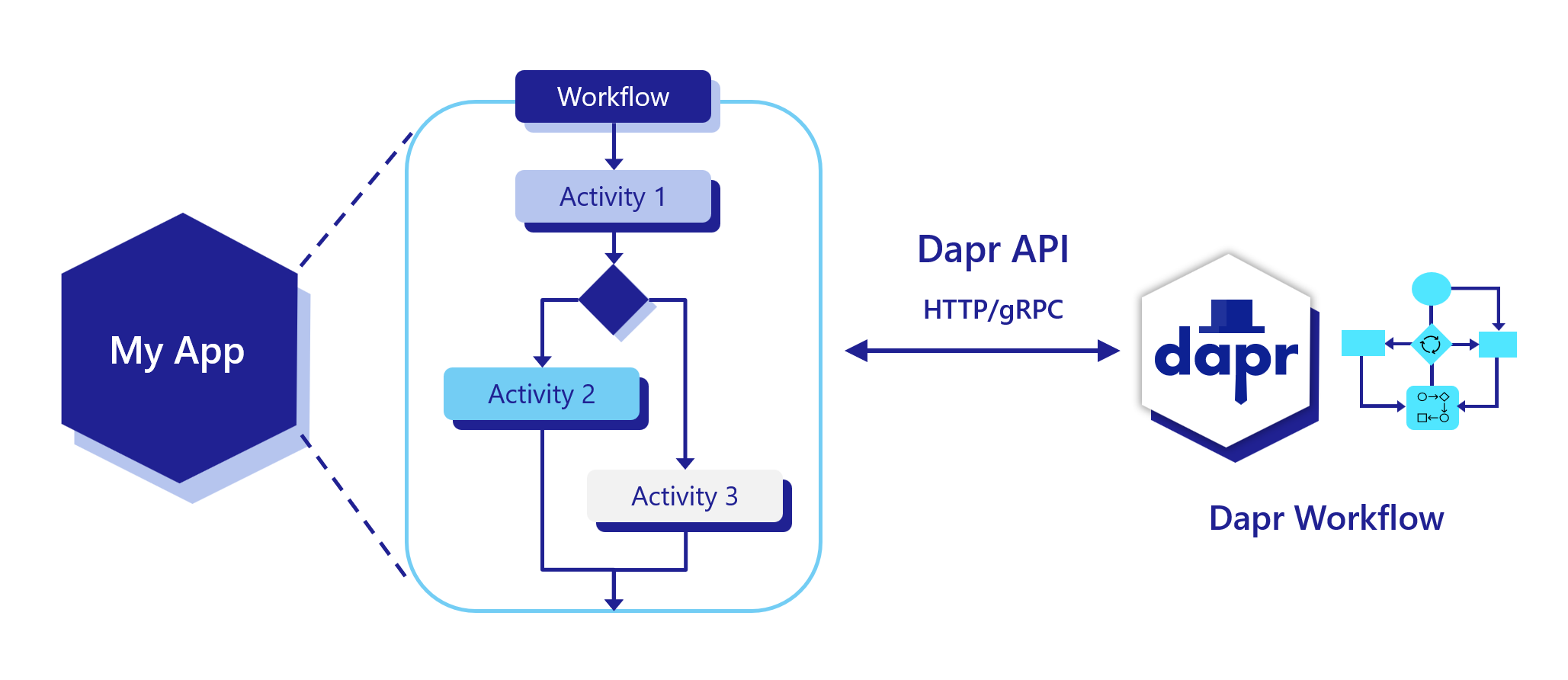The documentation you are viewing is for Dapr v1.11 which is an older version of Dapr. For up-to-date documentation, see the latest version.
Workflow overview
Note
Dapr Workflow is currently in alpha.Dapr workflow makes it easy for developers to write business logic and integrations in a reliable way. Since Dapr workflows are stateful, they support long-running and fault-tolerant applications, ideal for orchestrating microservices. Dapr workflow works seamlessly with other Dapr building blocks, such as service invocation, pub/sub, state management, and bindings.
The durable, resilient Dapr Workflow capability:
- Offers a built-in workflow runtime for driving Dapr Workflow execution.
- Provides SDKs for authoring workflows in code, using any language.
- Provides HTTP and gRPC APIs for managing workflows (start, query, pause/resume, raise event, terminate, purge).
- Integrates with any other workflow runtime via workflow components.

Some example scenarios that Dapr Workflow can perform are:
- Order processing involving orchestration between inventory management, payment systems, and shipping services.
- HR onboarding workflows coordinating tasks across multiple departments and participants.
- Orchestrating the roll-out of digital menu updates in a national restaurant chain.
- Image processing workflows involving API-based classification and storage.
Features
Workflows and activities
With Dapr Workflow, you can write activities and then orchestrate those activities in a workflow. Workflow activities are:
- The basic unit of work in a workflow
- Used for calling other (Dapr) services, interacting with state stores, and pub/sub brokers.
Learn more about workflow activities.
Child workflows
In addition to activities, you can write workflows to schedule other workflows as child workflows. A child workflow is independent of the parent workflow that started it and support automatic retry policies.
Learn more about child workflows.
Timers and reminders
Same as Dapr actors, you can schedule reminder-like durable delays for any time range.
Learn more about workflow timers and reminders
Workflow HTTP calls to manage a workflow
When you create an application with workflow code and run it with Dapr, you can call specific workflows that reside in the application. Each individual workflow can be:
- Started or terminated through a POST request
- Triggered to deliver a named event through a POST request
- Paused and then resumed through a POST request
- Purged from your state store through a POST request
- Queried for workflow status through a GET request
Learn more about how manage a workflow using HTTP calls.
Manage other workflow runtimes with workflow components
You can call other workflow runtimes (for example, Temporal and Netflix Conductor) by writing your own workflow component.
Workflow patterns
Dapr Workflow simplifies complex, stateful coordination requirements in microservice architectures. The following sections describe several application patterns that can benefit from Dapr Workflow.
Learn more about different types of workflow patterns
Workflow SDKs
The Dapr Workflow authoring SDKs are language-specific SDKs that contain types and functions to implement workflow logic. The workflow logic lives in your application and is orchestrated by the Dapr Workflow engine running in the Dapr sidecar via a gRPC stream.
Supported SDKs
You can use the following SDKs to author a workflow.
| Language stack | Package |
|---|---|
| .NET | Dapr.Workflow |
| Python | dapr-ext-workflow |
Try out workflows
Quickstarts and tutorials
Want to put workflows to the test? Walk through the following quickstart and tutorials to see workflows in action:
| Quickstart/tutorial | Description |
|---|---|
| Workflow quickstart | Run a .NET workflow application with four workflow activities to see Dapr Workflow in action |
| Workflow .NET SDK example | Learn how to create a Dapr Workflow and invoke it using ASP.NET Core web APIs. |
| Workflow Python SDK example | Learn how to create a Dapr Workflow and invoke it using the Python DaprClient package. |
Start using workflows directly in your app
Want to skip the quickstarts? Not a problem. You can try out the workflow building block directly in your application. After Dapr is installed, you can begin using workflows, starting with how to author a workflow.
Watch the demo
Watch this video for an overview on Dapr Workflow:
Next steps
Workflow features and concepts >>Related links
- Workflow API reference
- Try out the full SDK examples:
Feedback
Was this page helpful?
Glad to hear it! Please tell us how we can improve.
Sorry to hear that. Please tell us how we can improve.